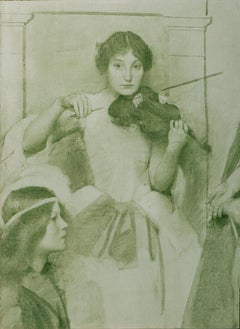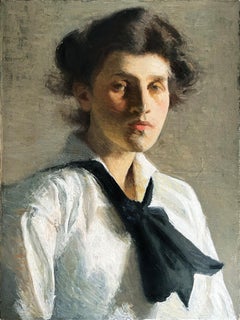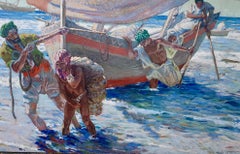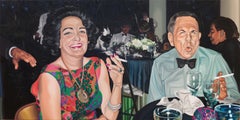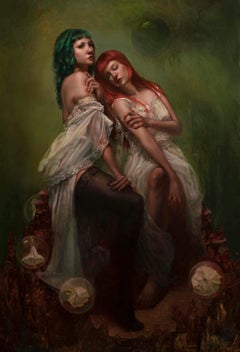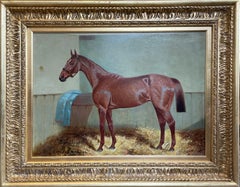Portrait Paintings
Early 1900s Aesthetic Movement Portrait Paintings
Oil
Early 1900s Realist Portrait Paintings
Oil
Early 1900s Impressionist Portrait Paintings
Canvas, Oil, Cardboard
Early 1900s American Impressionist Portrait Paintings
Canvas, Oil
Early 1900s Impressionist Portrait Paintings
Canvas, Oil
Early 1900s Portrait Paintings
Canvas, Oil
2010s American Realist Portrait Paintings
Canvas, Acrylic, Oil
2010s Contemporary Portrait Paintings
Oil, Panel
2010s Contemporary Portrait Paintings
Oil
Late 20th Century American Impressionist Portrait Paintings
Illustration Board, Oil, Pen
1950s American Impressionist Portrait Paintings
Oil, Canvas
1960s American Impressionist Portrait Paintings
Oil, Canvas, Cardboard
Mid-20th Century American Impressionist Portrait Paintings
Cardboard, Oil, Canvas
1980s Impressionist Portrait Paintings
Canvas, Oil, Cardboard
19th Century Portrait Paintings
Oil
1990s Impressionist Portrait Paintings
Cardboard, Tempera
Early 2000s American Impressionist Portrait Paintings
Canvas, Oil
17th Century Baroque Portrait Paintings
Oil, Canvas
Early 1900s Impressionist Portrait Paintings
Canvas, Oil
Early 1900s Portrait Paintings
Oil
Early 1900s Realist Portrait Paintings
Oil
Early 1900s Victorian Portrait Paintings
Canvas, Oil, Board
Early 1900s Modern Portrait Paintings
Canvas, Oil
Early 1900s Impressionist Portrait Paintings
Canvas, Oil
Early 1900s Portrait Paintings
Canvas, Oil, Color Pencil
Early 1900s Portrait Paintings
Oil
Early 1900s Impressionist Portrait Paintings
Oil
Early 1900s Impressionist Portrait Paintings
Canvas, Oil
Early 1900s Impressionist Portrait Paintings
Oil, Panel
Early 1900s Impressionist Portrait Paintings
Oil, Panel
Shop Antique and Vintage Portrait Paintings
An elegant and sophisticated decorative touch in any living space, portrait paintings have remained popular throughout the years and are widely loved pieces of art for display in many homes today.
Portrait paintings are at least as old as ancient Egypt, where realistic, lifelike depictions of the recently deceased — commonly known as “mummy portraits” — were painted on wooden panels and affixed to mummies as part of the burial tradition.
For centuries, painters have used portraiture as a means of expressing a subject’s nobility, societal status and authority. Portraits were given as gifts in Renaissance Europe, and a portrait artist might have been commissioned to help mark a significant occasion such as a wedding or a promotion to high office. Prior to the advent of photography, which eventually replaced painted portraits as a quicker and more efficient way of capturing a person’s essence, the subject of a portrait had to sit for hours until the painter had finished. And during the 18th century in particular, if an artist commissioned for a portrait struggled with how to adequately memorialize and capture a subject’s likeness, sometimes a portrait painting wasn’t completed for up to a year.
Whether it’s part of the gallery-style approach to your living-room or dining-room walls or merely inspiration as you devise an eye-grabbing color scheme in your home, a portrait painting is a timeless decorative object for any interior. A landscape painting or sculpture might give you the kind of insight into a specific region of the world or a different culture that you can ascertain only through art. Similarly, when you take the time to learn about the subject of a portrait painting that you bring into your home — the sitter’s history, the relationship between the sitter and the artist should one exist, the story of how the portrait came to be — that work can become intensely personal in addition to its place as an object for an art-hungry corner of your apartment or house.
On 1stDibs, visit a vast collection of famous portrait paintings or works by emerging artists. Search by medium to find the right portrait paintings for your home in oil paint, synthetic resin paint and more. Find portrait paintings in a variety of styles, too, including contemporary, Impressionist and Pop art, or search by artist to find unique works created by painters such as Mark Beard, Steve Kaufman and Montse Valdés.
Read More
Cecilia Vicuña Merges Politics, Science and Spirituality in Her Poetic Art
The Chilean creator, who has been living in exile in New York for decades, is having a major moment, receiving the biggest exhibitions, commissions and awards an artist could dream of.
In Christopher Spitzmiller’s New York Homes, His Love of Dogs Is on Full Display
The ceramist, designer and gentleman farmer tells us about the collection of antique dog art he has spread across a New York City apartment and a Greek Revival farmhouse in the Hudson Valley.
This Wiener Werkstätte Master Made Everything into Art
Koloman Moser smashed the conservative conventions of art and design in fin-de-siècle Vienna. On the 100th anniversary of his death, the Austrian designer is being celebrated for his radically modern creations.
A Rare Q&A with American Legend Alex Katz
On the eve of a new exhibition just north of New York City, the nonagenarian contemporary-art icon talked with ‘Introspective’ about his long and ongoing career, the development of his signature style and his rather malleable definition of realism.
